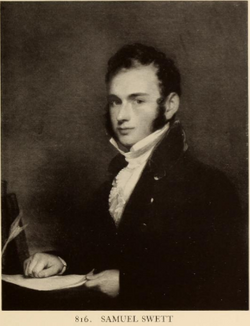Samuel Swett (1782-1866, shown here) consulted that collection, but he also assembled a file of his own documents as he wrote his “Historical and Topographical Sketch of Bunker Hill Battle,” published in 1818. In that essay he wrote (referring to himself in the third person):
The materials lay scattered among newspapers, magazines, records and files of Congress, the scattered surviving veterans of the day, and others. He was compelled by circumstances to commence his researches in July, and finish his sketch in August; but he reminded himself that our fathers fought for us in the same oppressive season, and spared no effort to render the work complete. Not a single fact is stated of which he has not the most satisfactory evidence. That the public however may judge for themselves, he has deposited his documents and proofs for their use at the Boston Athaeneum [sic].However, in a letter published in the Boston Daily Advertiser on 20 Dec 1825, Swett reported:
…the original documents which were collected in the defence of General [Israel] Putnam, and which I was permitted to use in preparing my sketch of the battle, were deposited in the Athenæum, and for some years have been lost, and not the slightest trace of them can be found.Fortunately, Swett said, he’d kept separate two documents he sent to that newspaper—the two I quoted last week.
At just about the same time, Swett published his “Notes to the Sketch of Bunker-Hill Battle,” quoting from his sources. On the first page of that appendix a footnote stated: “This, and every other statement referred to by the author, were taken down in writing at the time; any person who pleases may have copies taken of any documents in his possession.” Of course, the “documents in his possession” didn’t include those lost at the Athenæum.
Some people had transcribed parts of that collection, Swett explained on the next page (now using the second person plural): “As the original documents have long been lost from the Boston Athenæum, we can only say, the copies in the [Columbian] Centinel and N[orth]. A[merican]. Review are known to have been made by two gentlemen of as high honour and integrity as our country ever produced.”
On page 10 Swett switched to “statements taken down in writing by Gen. [William] Sullivan and other Directors of the Bunker Hill monument” in June 1825—the documents in that three-volume collection.
When Richard Frothingham, Jr., wrote his History of the Siege of Boston, first published in 1849, he wrote: “I am indebted to Colonel Samuel Swett for permission to take copies of his manuscripts.” Again, those might not have included the papers deposited at the Athenæum.
However, according to an item published in the New England Historic and Genealogical Register in 1920, at some point in the nineteenth century Swett’s original collection resurfaced. Artemas Ward of New York, descendant of the general of the same name, wrote that several people noted the recovery in their copies of Swett’s “Notes to the Sketch of Bunker-Hill Battle.” (I haven’t seen such a note.)
In May 1883, the New York book dealer Charles L. Woodward offered “Col. Swett’s Collection of Affidavits” for sale. This lot was said to include “nearly two hundred papers,” and the asking price was $200. Alas, there’s no information about where Woodward obtained that collection and where he sold it.
That makes two collections of documents about Bunker Hill collected within the lifetimes of the men who fought that battle which disappeared in the late 1800s. Any information about them would, of course, be appreciated.

No comments:
Post a Comment